
Papal Coinage
.pdf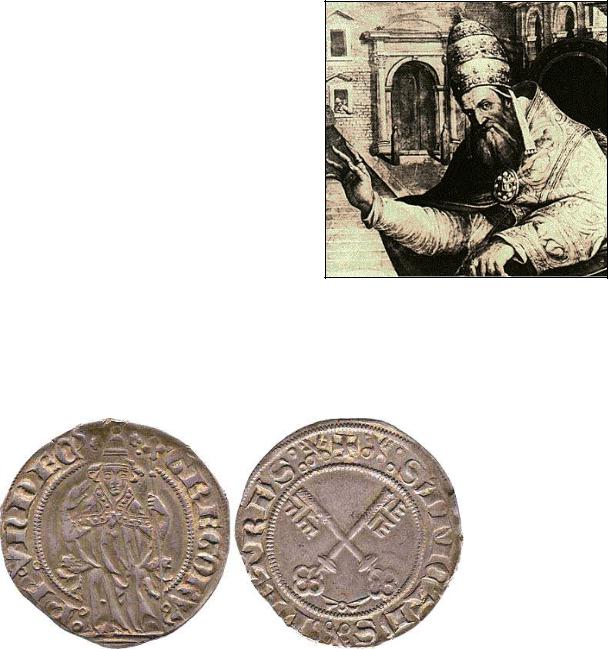
Gregory XI - 30 Dec. 1370 to 26 March 1378
Pope Gregory XI (c. 1336 – March 27, 1378), born Pierre Roger de Beaufort, Pope from 1370 to 1378, born in Rosiers-d'Égletons, Limousin around 1336, succeeded Pope Urban V (1362–70) in 1370 as one of the Avignon Popes.
During his pontificate vigorous measures were taken against the heresies which had broken out in Germany, England, and other parts of Europe; a sincere effort was also made to bring about a reformation in the various monastic orders. The nineteen propositions of John Wycliffe (c. 1320–84) and the thirteen articles of the Sachenspiegel were formally condemned by Pope Gregory XI in 1377.
His return to Rome is attributed in part to the stirring words of Catherine of Siena, January 27, 1377. This had been attempted by Gregory's predecessor, Urban V, without success. The project was delayed by a conflict between the pope and Florence, known as "the War of the Eight Saints" for the "Eight for War," the Florentine magistrates responsible for the conduct of the war. The pope put Florence under interdict for a time.
Gregory XI did not long survive this removal, dying on March 27, 1378. After his death the College of Cardinals was pressured by a Roman mob, that suc-
cessfully broke into the voting chamber, to vote an Italian Pope into the papacy. This Italian Pope was Urban VI. Soon after electing Urban he gained the Cardinals' enmity, so, with the encouragement of the French King the cardinals returned to Avignon and elected a French pope there, named Clement VII in 1378.
This mess created through the switching of popes by the Cardinals forced the people of Europe into a dilemma of papal allegiance. This Schism created was not fully resolved until the Council of Constance from 1414-1418, where the current popes were deposed and Martin V was voted in as Pope. This Schism and its difficulties brought about the reforming councils and gave them the power over who was elected, opposed to the College of Cardinals in the past.
PAPAL COINS
Gregory XI., 1370-1378.
Grosso. Avignon mint. 2.80 g.
Obv.: Tiara-crowned pope seated on chair with lion head decorations; right hand raised in blessing; left hand holding cross staff. GREGORV PP VNDEC’
Rev.: Crossed keys. +SANCTVS PETRVS crossed key dividers. U in SANCTUS gothic style.
Reference: - Ber. manque cf. 213 - Munt. manque cf. 14 Rare - unpublished. Superb.
Estimate: 1.500 / 2.000. Price realized: 1,600 EUR (approx. 2,035 U.S. Dollars as of the auction date)

PAPAL COINS
Gregory XI., 1370-1378.
Grosso. Avignon mint. 2.67 g.
Obv.: Tiara-crowned pope seated on chair with lion head decorations; right hand raised in blessing; left hand holding cross staff. GREGORV PP VNDEC
Rev.: Crossed keys. +SANCTVS PETRVS crossed key dividers.
Rare! Slight rim damage. VF.
Estimate: 300 EUR. Price realized: 650 EUR (approx. 996 U.S. Dollars as of the auction date)
PAPAL COINS
Gregory XI., 1370-1378.
Grosso. Avignon mint. 26 mm 2,51 g.
Obv.: Tiara-crowned pope seated on chair with lion head decorations; right hand raised in blessing; left hand holding cross staff. GREGORV PP VNDEC’
Rev.: Crossed keys. +SANCTVS PETRVS crossed key dividers.
Reference: M 14. B 213. Antique patina. XF.
Estimate CHF 350. Price realized: 480 CHF (approx. 355 U.S. Dollars as of the auction date)
PAPAL COINS
Gregory XI., 1370-1378.
Grosso. Avignon mint. 2.80 g.
Obv.: Tiara-crowned pope seated on chair with lion head decorations; right hand raised in blessing; left hand holding cross staff. GREGORV PP VNDEC’
Rev.: Crossed keys. +SANCTVS PETRVS crossed key dividers.
Reference: Muntoni 14. Very attractive example, with beautiful patina. XF.
Schätzpreis: 300.00 EUR. Price realized: 900 EUR (approx. 1,080 U.S. Dollars as of the auction date)
PAPAL COINS
Gregory XI., 1370-1378.
Bolognino. Rome mint. 0,94 g.
Obv.: Facing mitred bust; ‘S PETRVS P’
Rev.: URBI in center arranged in cross formation, ballin each angle, IN ROMA around.
Reference: Biaggi 2132; Berman 209.

PAPAL COINS
Gregory XI., 1370-1378.
Bolognino. Rome mint. 1,26 g.
Obv.: Tiara-crowned pope facing. GG PP UND’
Rev.: URBI in center arranged in cross formation, ball in each angle; IN ROMA around.
Dark patina, VF.
Estimate: 50 EUR. Price realized: 180 EUR (approx. 276 U.S. Dollars as of the auction date)
PAPAL COINS
Gregory XI., 1370-1378.
Bolognino. Rome mint.
Obv.: Tiara-crowned pope facing. GG PP UND’
Rev.: URBI in center arranged in cross formation, ball in each angle; IN ROMA around.
Reference: Muntoni 7, Biaggi 2132. F/VF.
Estimate: 35 EUR.
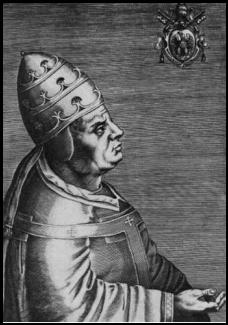
Urban VI - 8 Apr. 1378 to 15 Oct. 1389
Pope Urban VI (c. 1318 – October 15, 1389), born Bartolomeo Prignano, was Pope from 1378 to 1389.
Born in Naples, he was a devout monk and learned casuist, trained at Avignon. On March 21, 1364, he was consecrated Archbishop of Acerenza in the Kingdom of Naples. He became Archbishop of Bari in 1377, and, on the death of Pope Gregory XI (1370–78), the Roman populace clamorously demanding a Roman pope, and the cardinals being under some haste and pressure, Prignano was unanimously chosen (April 8, 1378) as acceptable as well to the disunited French cardinals, taking the name Urban VI. He was the last Pope to be elected from outside the College of Cardinals. Immediately following the conclave most of the cardinals fled Rome before the mob could learn that not a Roman, but a subject of Joanna of Naples, had been chosen.
Prignano had developed a reputation for simplicity and frugality, even austerity, a head for business when acting Vice-Chancellor and a penchant for learning, and, according to Cristoforo di Piacenza, he was without famiglia in an age of nepotism. His great faults undid his virtues: Ludwig Pastor summed up his character: "He lacked Christian gentleness and charity. He was naturally arbitrary and extremely violent and imprudent, and when he came to deal with the burning ecclesiastical question of the day, that of reform, the consequences were disastrous."
Though the coronation was carried out in scrupulous detail, leaving no doubt as to the legitimacy of the new pontiff, the French were not particularly happy with this move
and began immediately to conspire against this pope from the Regno. Urban VI did himself no favors; whereas the cardinals had expected him pliant, he was considered arrogant and angry by many of his contemporaries. Dietrich of Nieheim considered that the cardinals concluded that his elevation had turned his head, and Froissart, Leonardo Aretino, Tommaso de Acerno[6] and St. Antoninus of Florence recorded similar conclusions.
Immediately following his election, Urban began preaching intemperately to the cardinals, insisting that the business of the curia should be carried on without gratuities and gifts, forbidding the cardinals to accept annuities from rulers and other lay persons, condemning the luxury of their lives and retinues, and the multiplication of benefices and bishoprics in their hands. Nor would he remove again to Avignon, thus alienating Charles V of France, and, according to Urban's assessment, opening the Western Schism.
The cardinals were mortally offended. Five months after his election, the French cardinals met at Anagni, inviting Urban, who realized that he would be seized and perhaps slain; in his absence they issued a manifesto of grievances (August 9), declaring the election invalid and claiming that they had been cowed by the mob into electing an Italian, followed by letters (August 20) to the missing Italian cardinals, declaring sede vacante. Then at Fondi, secretly supported by the king of France, they proceeded to elect Robert of Geneva (September 20). He took the title of Clement VII (1378–94). Thus began the Western Schism (1378–1417) which divided Catholic Christendom for nearly forty years.
Urban was excommunicated by the French pope and designated the Antichrist, while Catherine of Siena called the cardinals "devils in human form". Coluccio Salutati identified the political nature of the withdrawal: "Who does not see," the Chancellor openly addressed the French cardinals, "that you seek not the true pope, but opt solely for a Gallic pontiff." Opening rounds of argument were embodied in John of Legnano's defense of the election, De fletu ecclesiæ, written and increment ally revised between 1378 and 1380, which Urban saw to it was distributed in multiple copies, and in the numerous rebuttals that soon appeared. Events overtook the rhetoric, however; twenty-six new cardinals were created in a single day, and by an arbitrary alienation of the estates and property of the church, funds were raised for open war. At the end of May 1379 Clement went to Avignon, where he was more than ever at the mercy of the king of France. Louis, duc d'Anjou, was granted a phantom kingdom of Adria to be carved out of papal Emilia and Romagna, if he could unseat the pope at Rome.
Urban's erstwhile patroness, Joanna of Naples, deserted him in the late summer of 1378,[13] in part because her former archbishop had become her feudal suzerain, and Urban now lost sight of the larger issues and began to commit a series of errors. He turned upon his powerful neighbor, excommunicated her as an obstinate partisan of Clement, and permitted a crusade to be preached against her. Soon her enemy and cousin, the "crafty and ambitious" Charles of Durazzo, representing the Sicilian Angevin line, forgetting his French blood, was glad to be invested in the sovereignty of Naples (June 1, 1381), declared to be forfeited by Joanna— whom he murdered in 1382— and was crowned by Urban.
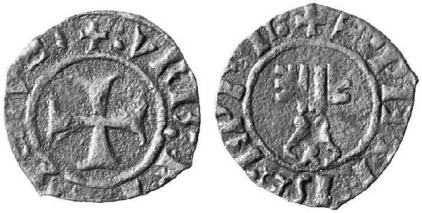
"In return for these favours, Charles had to promise to hand over Capua, Caserta, Aversa, Nocera, Amalfi to the pope's nephew, a thoroughly worthless and immoral man." Once ensconced at Naples, Charles found his new kingdom invaded by Louis d'Anjou; hard-pressed, he reneged on his promises. In Rome the Castel Sant'Angelo was besieged and taken, and Urban forced to flee; Urban in the fall of 1383 unwisely determined to go to Naples and press Charles in person. There he found himself virtually a prisoner. After a first reconciliation, with the death of Anjou (September 20, 1384), Charles found himself freer to resist Urban's feudal pretensions, and relations took a turn for the worse; Urban was shut up in Nocera, from the walls of which he daily fulminated his anathemas against his besiegers, with bell, book and candle; a price was set on his head.
He succeeded in making his escape to Genoa. Several among his peregrine cardinals, who had been shut up in Nocera with him, determined to make a stand: they determined that a pope, who by his incapacity or blind obstinacy, might be put in the charge of one of the cardinals. Urban had them seized, tortured and put to death, "a crime unheard of through the centuries" the chronicler Egidio da Viterbo remarked.
His support had dwindled to the northern Italian states, Portugal, England, and Charles IV, Holy Roman Emperor, who brought with him the support of most of the princes and abbots of Germany.
On the death of Charles (February 24, 1386), set himself at the head of his troops, apparently with the intention of seizing Naples for his nephew if not for himself, for he had never lost sight of his feudal rights in the Regno. To raise funds he proclaimed a Jubilee, though only thirty-three years had elapsed since that celebrated under Pope Clement VI (1342–52), but before the celebration he died "unlamented" at Rome of injuries caused by a fall from his mule, not without rumors of poisoning.
His successor was Pope Boniface IX (1389–1404).
PAPAL COINS
Urban VI, 1378-1389.
Denaro paparino. Viterbo mint. 15 mm 0,44 g.
Obv.: Cross pattee.
Rev.: Two upright keys.
Reference: M 4 var. B 219. Rare!
Estimate CHF 500. Price realized: 900 CHF (approx. 665 U.S. Dollars as of the auction date)
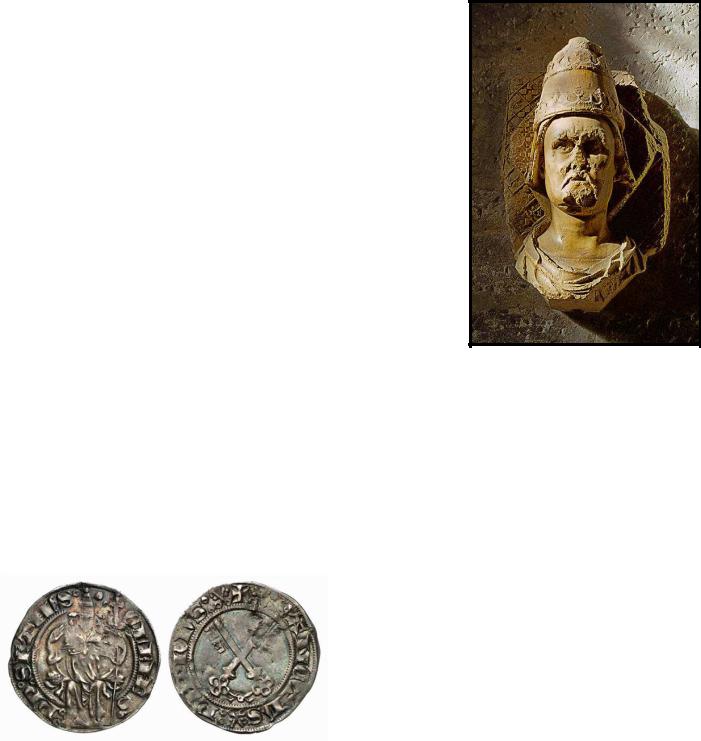
Anti-Pope Clement VII - 1378–1394
Robert of Geneva (1342–16 September 1394) was elected to the papacy as (Anti-)Pope Clement VII by the French cardinals who opposed Urban VI, and was the first Avignon antipope of the Western Schism.
He was the son of Amadeus III, Count of Geneva, and was born in Geneva, in what is now Switzerland, in 1342. Appointed Protonotary Apostolic in 1359, he became Bishop of Thérouanne in 1361, Archbishop of Cambrai in 1368, and a cardinal on 30 May 1371.
In 1377, while serving as papal legate in upper Italy (1376-78), in order to put down a rebellion in the Papal States, known as the War of the Eight Saints, he personally commanded troops lent to the papacy by the condottiere John Hawkwood to reduce the small city of Cesena in the territory of Forlì, which resisted being added to the Patrimony of Peter for the second time in a generation; there he allegedly authorized the massacre of 4,000 civilians, an atrocity even by the rules of war at the time, which earned him the nickname butcher - or executioner of Cesena.
Elected pope at Fondi on 20 September 1378 by the French cardinals in opposition to Urban VI, he was the first antipope of the Western Schism, the second of the two periods sometimes referred to as the Great Schism, which lasted until 1417. France, Scotland, Castile, Aragon, Navarre, Portugal, Savoy, Denmark, Norway, and some minor German states acknowledged his
authority. Unable to maintain himself in Italy, he took up his residence at Avignon in the southern French Comtat Venaissin, where he became dependent on the French court. He created excellent cardinals but donated the larger part of the Pontifical States to Louis II of Anjou, resorted to simony and extortion to meet the financial needs of his court, and seems never to have sincerely desired the termination of the schism.
He died at Avignon on 16 September 1394.
Eventually it was determined that he would be recorded as an antipope rather than as a pope. Uncertainty over who the legitimate pope might be during the time of the Western Schism gave rise to the legal theory called Conciliarism, which claimed that a general council of the church was superior to the pope and could therefore judge between rival claimants.
PAPAL COINS
Clement VII., Anti-Pope, 1378-1394.
Grosso. Avignon mint. 2,75 g.
Obv.: Tiara-crowned pope enthroned on seat decorated with lion heads, right hand raised in blessing, cross staff in left hand. CLEMENSPP SETHVS
Rev. Ornate crossed keys. + SANCTVS PETRVS crossed key dividers.
Reference: Muntoni 6. Rare, Attractive Patina, VF.
Estimate: 500.00 EUR. Price realized: 1,000 EUR (approx. 1,200 U.S. Dollars as of the auction date)
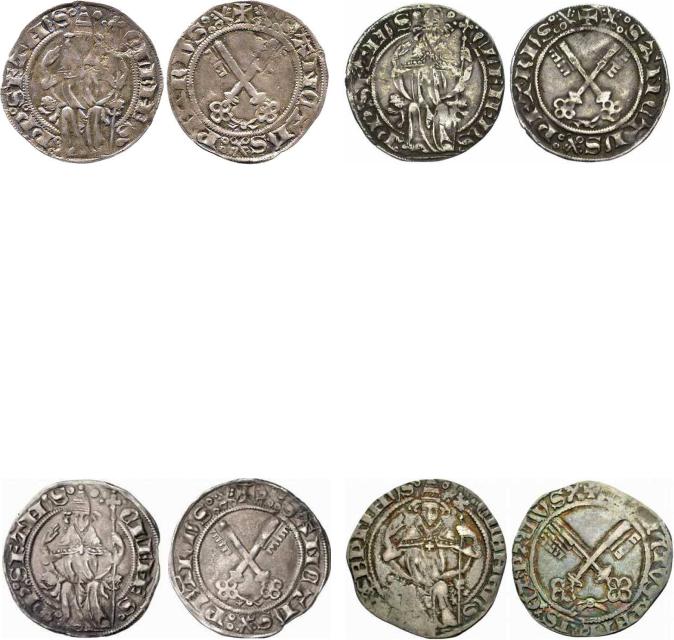
PAPAL COINS
Clement VII., Anti-Pope, 1378-1394.
Grosso. Avignon mint. 2,74 g.
Obv.: Tiara-crowned pope enthroned on seat decorated with lion heads, right hand raised in blessing, cross staff in left hand. CLEMESPP SETHVS (Clemes in lieu of Clemens).
Rev. Ornate crossed keys. + SANCTVS PETRVS crossed key dividers.
Reference: Ber. manque cf. 232 - Munt. manque cf. 6. Rare! Unpublished.
Estimate: 1.500 / 2.000. Price realized: 1,700 EUR (approx. 2,162 U.S. Dollars as of the auction date)
PAPAL COINS
Clement VII., Anti-Pope, 1378-1394.
Grosso. Avignon mint. 2,75 g.
Obv.: Tiara-crowned pope enthroned on seat decorated with lion heads, right hand raised in blessing, cross staff in left hand. CLEMENSPP SETHVS
Rev. Ornate crossed keys. + SANCTVS PETRVS crossed key dividers.
Reference: Muntoni 6. Very rare, VF.
Estimate: 1250 EUR. Price realized: 1,400 EUR (approx. 2,146 U.S. Dollars as of the auction date)
PAPAL COINS
Clement VII., Anti-Pope, 1378-1394.
Grosso. Avignon mint. 2,29 g.
Obv.: Tiara-crowned pope enthroned on seat decorated with lion heads, right hand raised in blessing, cross staff in left hand. CLEMENSPP SETHVS
Rev. Ornate crossed keys. + SANCTVS PETRVS crossed key dividers.
Reference: B., 915 var; P.A., 4198; Munt., 6; Berman, 232. Very rare! F - VF
Estimate: EUR 500.
PAPAL COINS
Clement VII., Anti-Pope, 1378-1394.
Grosso. Avignon mint. 24 mm 2,45 g.
Obv.: Tiara-crowned pope enthroned on seat decorated with lion heads, right hand raised in blessing, cross staff in left hand. Legend reads CLEMENSPP SEPTIHVS
Rev. Ornate crossed keys. + SANCTVS PETRVS ET PAULVS (ul LIGATE) crossed key dividers.
Reference: Munt. 7. Berman 233. VF.
Estimate: EUR 200. Price realized: 310 EUR (approx. 391 U.S. Dollars as of the auction date)
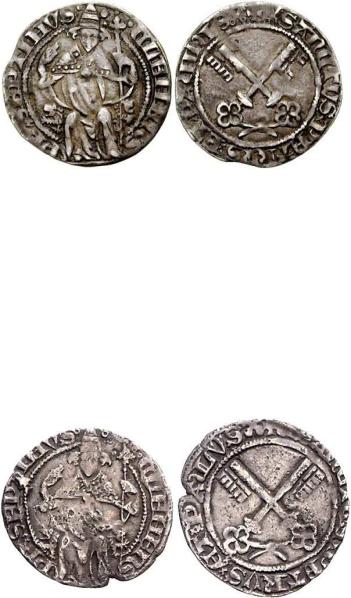
PAPAL COINS
Clement VII., Anti-Pope, 1378-1394.
Grosso. Avignon mint. 2,49 g.
Obv.: Tiara-crowned pope enthroned on seat decorated with lion heads, right hand raised in blessing, cross staff in left hand. Legend reads CLEMENSPP SEPTIHVS
Rev. Ornate crossed keys. + SANCTVS PETRVS ET PAULVS (ul LIGATE) crossed key dividers.
Reference: Muntoni IV pg.144, 7; Berman 233. Good VF. Rare. Clement VII was the first anti-pope of the Schism, opposing Bartolomeo Prigano (Urban VI). There are also earlier examples of particularly odious pontiffs being deposed as anti-popes, but none of these individuals struck papal coins.
Estimate $500. Price realized: 575 USD.
PAPAL COINS
Clement VII., Anti-Pope, 1378-1394.
Grosso. Avignon mint. 2,41 g.
Obv.: Tiara-crowned pope enthroned on seat decorated with lion heads, right hand raised in blessing, cross staff in left hand. Legend reads CLEMENSPP SEPTIHVS
Rev. Ornate crossed keys. + SANCTVS PETRVS ET PAULVS (ul LIGATE) crossed key dividers.
Reference: Muntoni 7 var.. Cut, scratches. F-VF.
Estimate: 100 EUR. Price realized: 220 EUR (approx. 319 U.S. Dollars as of the auction date)
Boniface IX - 2 Nov. 1389 to 1 Oct. 1404
Pope Boniface IX (1356 – October 1, 1404), born Piero Tomacelli, was the second Roman Pope of the Western Schism from November 2, 1389 – until October 1, 1404. During his time the antipope Clement VII (1378–94) continued to hold court as pope in Avignon under the protection of the French monarchy.
Piero (also Perino, Pietro) Tomacelli came of an ancient but impoverished baronial family of Naples. An unsympathetic German contemporary source, Dietrich of Nieheim, asserted that he was illiterate (nesciens scribere etiam male cantabat); neither a trained theologian nor skilled in the business of the Curia, he was tactful and prudent in a difficult era, but Ludwig Pastor, who passes swiftly over his pontificate, says, "The numerous endeavours for unity made during this period form one of the saddest chapters in the history of the Church. Neither Pope had the magnanimity to put an end to the terrible state of affairs" by resigning.[1] Germany, England, Hungary, Poland, and the greater part of Italy accepted him as pope, (he and the Avignon Pope Clement VII having mutually excommunicated one another) but the day before Tomacelli's election by the fourteen cardinals who remained faithful to the papacy at Rome, Clement VII at Avignon had just crowned a French prince, Louis II of Anjou, King of Naples. The youthful Ladislaus was rightful heir of Charles III of Naples, assassinated in 1386, and Margaret of Durazzo, scion of a line that had traditionally supported the popes in their struggles in Rome with the anti-papal party in the city itself. Boniface IX saw to it that Ladislaus was crowned King of Naples at Gaeta May 29, 1390) and worked with him for the next decade to expel the Angevin forces from southern Italy.
In the course of his reign Boniface IX finally extinguished the troublesome independence of the commune of Rome and established temporal control, though it required fortifying not only the Castel Sant'Angelo, but the very bridges, and for long seasons he was forced to reside in more peaceful surroundings, at Assisi or Perugia. He also took over the port of Ostia from its Cardinal Bishop. In the Papal States Boniface IX gradually regained control of the chief castles and cities, and he re-founded the States as they would appear during the fifteenth century.
Clement VII died at Avignon, September 16, 1394, but the French cardinals quickly elected a successor, on September 28: Cardinal Pedro de Luna, who took the name Benedict XIII (1394—1423). Over the next few years Boniface IX was entreated to abdicate, even by his strongest supporters: Richard II of England (in 1396), the Diet of Frankfurt (in 1397), and King Wenceslaus of Germany (at Reims, 1398). But he refused. Pressure for an ecumenical council also grew as the only way to breach the Great Schism, but the conciliar movement made no headway during Boniface IX's papacy.
During the reign of Boniface IX two jubilees were celebrated at Rome. The first, in 1390, had been declared by his predecessor Pope Urban VI, and was largely frequented by people from Germany, Hungary, Poland, Bohemia, and England. Several cities of Germany obtained the "privileges of the jubilee", as indulgences were called, but the preaching of indulgences gave rise to abuses and scandal. The jubilee of 1400 drew to Rome great crowds of pilgrims, particularly from France, in spite of a disastrous plague. Pope Boniface IX remained in the city.
In the latter part of 1399 there arose bands of self-flagellating penitents, known as the Bianchi, or Albati ("White Penitents"), especially in Provence, where the Albigenses had been exterminated less than a century before, and spreading to Spain and northern Italy. These evoked uneasy memories of the mass processions of wandering flagellants of the Black Death period, 1348—1349.
They went in procession from city to city, clad in white garments, with faces hooded, and wearing on their backs a red cross, following a leader who carried a large cross. Rumors of imminent divine judgement and visions of the Virgin Mary abounded. They sang the newly popular hymn Stabat Mater during their processions. For a while, as the White Penitents approached Rome, gaining adherents along the way, Boniface IX and the Curia supported their penitential enthusiasm, but when they reached Rome, Boniface IX had their leader burnt at the stake, and they soon dispersed. "Boniface IX gradually discountenanced these wandering crowds, an easy prey of agitators and conspirators, and finally dissolved them." as the Catholic Encyclopedia reports.
In England the anti-papal preaching of John Wyclif supported the opposition of the King and the higher clergy to Boniface IX's habit of granting English benefices as they fell vacant to favorites in the Roman Curia. Boniface IX introduced a novelty in the form of revenue known as annates perpetuæ, withholding half the first year's income of every benefice granted in the Roman Court. The pope's agents also now sold not simply a vacant benefice but the expectation of one; and when an expectation had been sold, if another offered a larger sum for it, the pope voided the first sale; the unsympathetic observer Dietrich von Nieheim reports that he saw the same benefice sold several times in one week, and that the Pope talked business with his secretaries during Mass. There was resistance in England, the staunchest supporter of the Roman papacy during the Schism: the English Parliament confirmed and extended the statutes of Provisors and Præmunire of Edward III of England (1327–77), giving the king veto power over papal appointments in England. Boniface IX was defeated in the face of a unified front, and the long controversy was finally settled, to the English king's satisfaction. Nevertheless, at the Synod of London (1396), the English bishops convened to condemn Wyclif.
In Germany the Electors had met at Rhense (August 20, 1400) to depose the unworthy Wenceslaus, and had chosen in his place Rupert, Duke of Bavaria and Rhenish Count Palatine. In 1403 Boniface IX made the best of it and approved the deposition and recognized Rupert.

In 1398 and 1399 Boniface IX appealed to Christian Europe in favor of the Byzantine emperor Manuel II Palaeologus, threatened at Constantinople by Sultan Bayezid I, but there was little enthusiasm for a new crusade at such a time. Saint Birgitta of Sweden was canonized by Pope Boniface IX, October 7, 1391. The universities of Ferrara (1391) and Fermo (1398) owe him their origin, and that of Erfurt (in Germany), its confirmation (1392).
Boniface IX died in 1404 after a brief illness.
Boniface IX was a frank politician, strapped for cash like the other princes of Europe, as the costs of modern warfare rose and supporters needed to be encouraged by gifts, for fourteenth-century government depended upon such personal support as a temporal ruler could gather and retain. All of the princes of the late fourteenth century were accused of avaricious money-grubbing by contemporary critics, but among them contemporaries ranked Boniface IX exceptional. Traffic in benefices, the sale of dispensations, and the like, did not cover the loss of local sources of revenue in the long absence of the papacy from Rome, foreign revenue diminished by the schism, expenses for the pacification and fortification of Rome, the constant wars necessitated by French ambition and the piecemeal reconquest of the Papal States. Boniface IX certainly provided generously for his mother, his brothers Andrea and Giovanni, and his nephews in the spirit of the day. The Curia was perhaps equally responsible for new financial methods that were destined in the next century to arouse bitter feelings against Rome, particularly in Germany.
(Note on numbering: Pope Boniface VII is now considered an anti-pope. At the time however, this fact was not recognized and so the seventh true Pope Boniface took the official number VIII. This caused the true eighth Pope Boniface to take the number IX. This has advanced the numbering of all subsequent Popes Boniface by one. Popes Boniface VIII-IX are really the seventh through eight popes by that name.)
PAPAL COINS
Boniface IX., 1389-1404.
Grosso. Rome mint. 2,48 g.
Obv.: Tiara-crowned pope enthroned on seat decorated with lion heads, right hand raised in blessing, cross staff in left hand. Legend reads BONIFAT PP NONVS
PAPAL COINS
Boniface IX., 1389-1404.
Bolognino. Rome mint.
Obv.: Tiara-crowned bust facing, BONIFAT.PP.N
Rev.: IN ROMA, around U-R-B-I arranged in cruciform.
Rev. Ornate crossed keys. + SANCTVS PETRVS crossed key dividers. |
Reference: Muntoni 5, Biaggi 2135. Prägeschwäche, sehr schön |
Rare, slightly corroded. VF. |
Estimate: 90 EUR. |
Estimate: 300 EUR. Price realized: 650 EUR (approx. 996 U.S. Dollars as |
|
of the auction date) |
|
